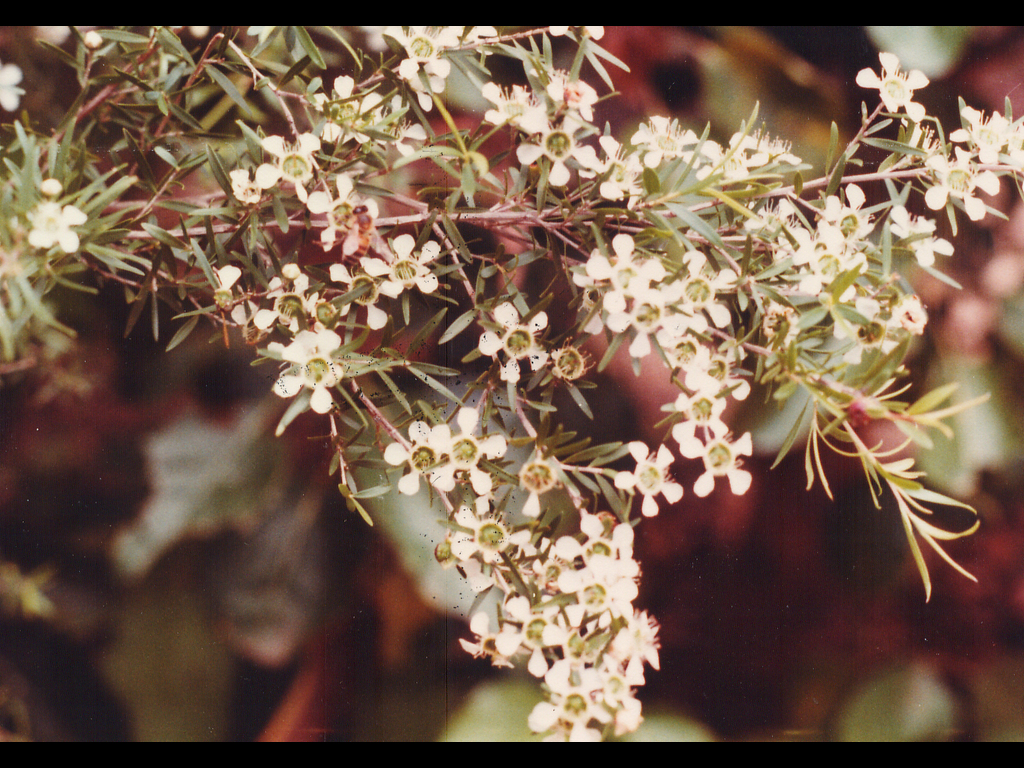Leptospermum 'Lemon Frost'
- File Number
- 293
- ACRA Field Book Number
- -
- Registration Date
- 16/10/1992
- Application Received
- 01/01/1981
- Family
- Myrtaceae
- Cultivar Name
- Leptospermum 'Lemon Frost'
- Origin
- Leptospermum 'Lemon Frost' arose from seed of Leptospermum petersonii and is presumed to be a hybrid between L. petersonii and a form of L. polygalifolium. It was first raised by M.P Haupt, Honeyview Native Nursery, Cairns, Queensland, in January 1981. Registration was applied for by M.P.Haupt in November 1982.
- Characteristics
- This cultivar is a shrub ca. 2m. x 1.5m. The leaves are bright green, dense, approximately 24mm long x 2mm wide on a short petiole to 1mm long, sparsely hairy when young but soon becoming glabrous, apex acute, base narrowed, with conspicuous oil glands, lemon scented. The flowers are solitary, approximately 20mm across, more or less sessile, petals white and approximately 5mm long. The flowering season is from late spring to early summer. Diagnosis: Leptospermum petersonii: Shrub to 4 x 3m, leaves 10-35mm x 2-4mm, on a short petiole to 1mm long, narrowly elliptic, apex rounded often notched, base cuneate; sparsely hairy when young but soon glabrous, conspicuous oil glands, lemon scented; flowers solitary, petals white 5-7mm long, appearing in spring and early summer. Leptospermum 'Lemon Frost': Shrub ca. 2 x 1.5m, leaves ca. 24mm x 2mm on a short petiole to 1mm long, narrowly elliptic, apex acute, base narrowed, sparsely hairy when young but soon glabrous, conspicuous oil glands, lemon scented; flowers solitary, petals white, ca. 5mm long, in spring and early summer. Leptospermum polygalifolium: Shrub to 4 x 2m, leaves 8-22mm x 1.5-4mm on a petiole to 2mm long, narrowly elliptic, apex obtuse to acute, base narrowed, glabrous; flowers solitary, petals white 4-6mm long, in spring and early summer. In general, Leptospermum 'Lemon Frost' has a habit which is intermediate between the two parents. It is more upright than L. petersonii and much denser than L. polygalifolium. It has finer leaves than L. petersonii, although still lemon scented, and flowers more prolifically. The flowering habit more closely resembles L. polygalifolium.
- Cultivation
- This cultivar is said to have good drought hardiness, however its tolerance to frost has not been determined. Propagation must be by vegetative means to preserve the cultivar form. It flowers prolifically and forms a dense shrub of suitable size for most gardens.
- Publication
- Australian Cultivar Registration Authority (1993), Australian Plant Cultivars. Australian Plants 17(134): 58
- Colour Coding
- RHS Colour Code 1966petals: White Group 155B
- Propagation
- Cuttings from semi-firm new growth
- Applicant Name
- M P Haupt
- Uses
- As part of a mass planting or mixed in a shrubbery, or as a spectacular feature plant.
- Availability
- Specialist native plant nurseries
- ANBG Accession Numbers
- ACC293; CBG8209109. G. Butler 1285
- NSL ID
- -
